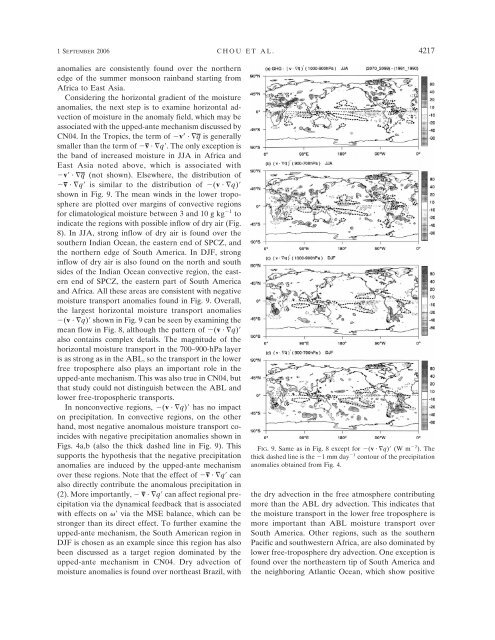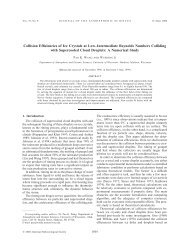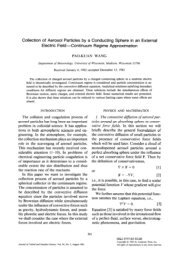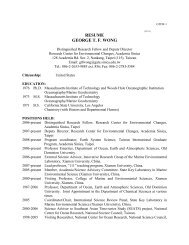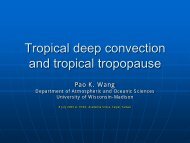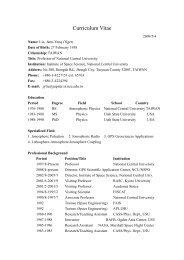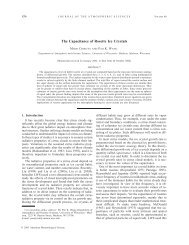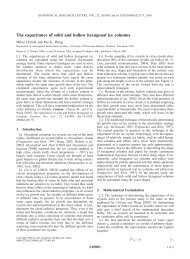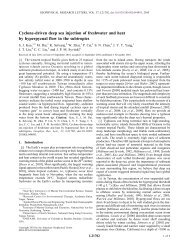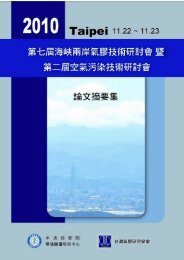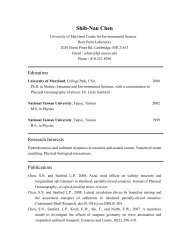Regional Tropical Precipitation Change ... - Academia Sinica
Regional Tropical Precipitation Change ... - Academia Sinica
Regional Tropical Precipitation Change ... - Academia Sinica
You also want an ePaper? Increase the reach of your titles
YUMPU automatically turns print PDFs into web optimized ePapers that Google loves.
1SEPTEMBER 2006 C H O U E T A L . 4217<br />
anomalies are consistently found over the northern<br />
edge of the summer monsoon rainband starting from<br />
Africa to East Asia.<br />
Considering the horizontal gradient of the moisture<br />
anomalies, the next step is to examine horizontal advection<br />
of moisture in the anomaly field, which may be<br />
associated with the upped-ante mechanism discussed by<br />
CN04. In the Tropics, the term of v · q is generally<br />
smaller than the term of v · q. The only exception is<br />
the band of increased moisture in JJA in Africa and<br />
East Asia noted above, which is associated with<br />
v · q (not shown). Elsewhere, the distribution of<br />
v · q is similar to the distribution of (v · q)<br />
shown in Fig. 9. The mean winds in the lower troposphere<br />
are plotted over margins of convective regions<br />
for climatological moisture between 3 and 10 g kg 1 to<br />
indicate the regions with possible inflow of dry air (Fig.<br />
8). In JJA, strong inflow of dry air is found over the<br />
southern Indian Ocean, the eastern end of SPCZ, and<br />
the northern edge of South America. In DJF, strong<br />
inflow of dry air is also found on the north and south<br />
sides of the Indian Ocean convective region, the eastern<br />
end of SPCZ, the eastern part of South America<br />
and Africa. All these areas are consistent with negative<br />
moisture transport anomalies found in Fig. 9. Overall,<br />
the largest horizontal moisture transport anomalies<br />
(v · q) shown in Fig. 9 can be seen by examining the<br />
mean flow in Fig. 8, although the pattern of (v · q)<br />
also contains complex details. The magnitude of the<br />
horizontal moisture transport in the 700–900-hPa layer<br />
is as strong as in the ABL, so the transport in the lower<br />
free troposphere also plays an important role in the<br />
upped-ante mechanism. This was also true in CN04, but<br />
that study could not distinguish between the ABL and<br />
lower free-tropospheric transports.<br />
In nonconvective regions, (v · q) has no impact<br />
on precipitation. In convective regions, on the other<br />
hand, most negative anomalous moisture transport coincides<br />
with negative precipitation anomalies shown in<br />
Figs. 4a,b (also the thick dashed line in Fig. 9). This<br />
supports the hypothesis that the negative precipitation<br />
anomalies are induced by the upped-ante mechanism<br />
over these regions. Note that the effect of v · q can<br />
also directly contribute the anomalous precipitation in<br />
(2). More importantly, v · q can affect regional precipitation<br />
via the dynamical feedback that is associated<br />
with effects on via the MSE balance, which can be<br />
stronger than its direct effect. To further examine the<br />
upped-ante mechanism, the South American region in<br />
DJF is chosen as an example since this region has also<br />
been discussed as a target region dominated by the<br />
upped-ante mechanism in CN04. Dry advection of<br />
moisture anomalies is found over northeast Brazil, with<br />
FIG. 9. Same as in Fig. 8 except for (v · q) (W m 2 ). The<br />
thick dashed line is the 1 mmday 1 contour of the precipitation<br />
anomalies obtained from Fig. 4.<br />
the dry advection in the free atmosphere contributing<br />
more than the ABL dry advection. This indicates that<br />
the moisture transport in the lower free troposphere is<br />
more important than ABL moisture transport over<br />
South America. Other regions, such as the southern<br />
Pacific and southwestern Africa, are also dominated by<br />
lower free-troposphere dry advection. One exception is<br />
found over the northeastern tip of South America and<br />
the neighboring Atlantic Ocean, which show positive


